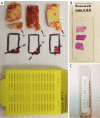NHERF1/EBP50 immunoexpression in renal cell carcinomas and oncocytomas with ultrastructural analysis of clear cell renal cell carcinoma
- PMID: 37680228
- PMCID: PMC10481195
- DOI: 10.21037/tau-23-101
NHERF1/EBP50 immunoexpression in renal cell carcinomas and oncocytomas with ultrastructural analysis of clear cell renal cell carcinoma
Abstract
Background: Na+/H+ exchanger (NHE) maintains the alkaline pH of epithelial cells working at the cellular membrane and exchanging H+/Na+ ions. In renal tubular epithelial cells, the reabsorption of NaCl is implemented by NHE3 isoform, which is regulated by NHE regulatory factor-1 (NHERF1). Normally situated at the apical zones of proximal tubular cells, NHERF1 participates in cytoskeletal reorganization and signal transduction facilitating structural stability and ion exchange. Based on an extensive search in English literature, NHERF1/EBP50 immunoexpression has been studied in breast, colon, and other tumors with only one study on 21 cases of renal cell carcinomas (RCC).
Methods: Using NHERF1/EBP50 immunohistochemistry (IHC) on 64 (82%) RCCs (34 clear cells, 21 papillary and 9 chromophobe types) and 14 (18%) oncocytomas, we evaluated and scored NHERF1/EBP50 immunoexpression depending on the World Health Organization (WHO)/International Society of Urological Pathology (ISUP) grading system followed by ultrastructural identification of microlumen-like structures (MLS) in clear cell renal cell carcinomas (ccRCC).
Results: Staining patterns varied throughout the tumors and within individual tumors. Only ccRCC showed unique MLS within the cytoplasm of tumor cells. All neoplasia-transformed tubular cells, regardless of the tumor grade and stage, had altered immunoexpression of NHERF1/EBP50 ranging from complete absence to aberrant expression in the luminal cell membrane, nuclear or cytoplasmic localizations.
Conclusions: Only ccRCC showed unique dot-like condensations of immunostaining/MLS at membranous, submembranous, and paranuclear localizations. The latter two localizations were mainly observed in the combined WHO/ISUP grade 1 and 2 group compared to the combined group of grade 3 and 4 tumor samples (P=0.0146 and P<0.0001, respectively). Ultrastructurally, the MLS were identified as thick microvilli trapped by a single-layer membrane, displaced into the cytoplasm and ranging from 400 nm to 3.5 µm. These significant ultrastructural reorganizations may contribute to tumor progression, metastasis, and drug resistance.
Keywords: NHERF1/EBP50; electron microscopy; microlumen; oncocytoma; renal cell carcinoma (RCC).
2023 Translational Andrology and Urology. All rights reserved.
Conflict of interest statement
Conflicts of Interest: All authors have completed the ICMJE uniform disclosure form (available at https://tau.amegroups.com/article/view/10.21037/tau-23-101/coif). The authors have no conflicts of interest to declare.
Figures





References
LinkOut - more resources
Full Text Sources
Miscellaneous
